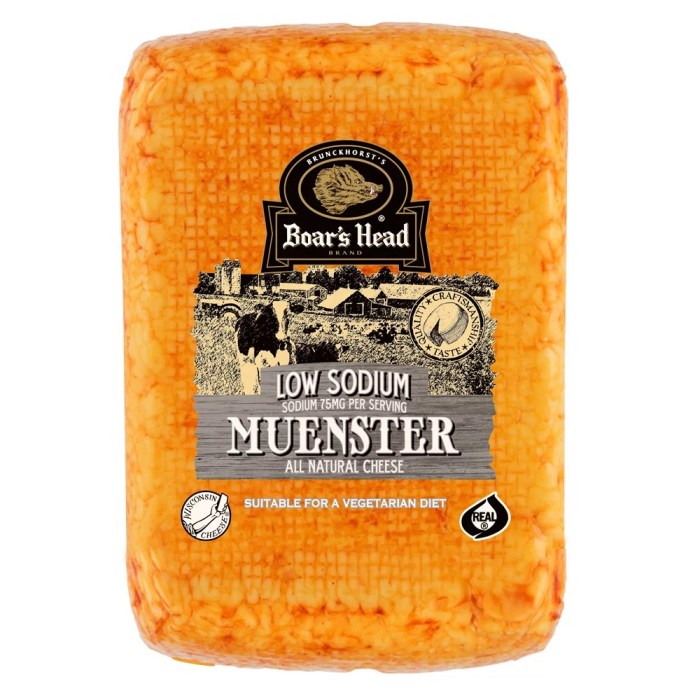Micronutrient Content and Health Implications

Boar’s head muenster cheese nutrition facts – Boar’s Head Muenster cheese, like many cheeses, offers a range of essential micronutrients contributing to overall health and well-being. Understanding its vitamin and mineral profile allows for informed dietary choices and appreciation of its nutritional value beyond its creamy texture and distinct flavor. This section details the micronutrient content of Boar’s Head Muenster cheese and explores the associated health benefits.
Boar’s Head Muenster cheese contains a variety of vitamins and minerals, although the exact amounts vary depending on the size of the serving and the specific manufacturing process. Nutritional information is typically found on the product packaging.
Vitamin and Mineral Composition of Boar’s Head Muenster Cheese
A serving of Boar’s Head Muenster cheese provides notable amounts of several vitamins and minerals crucial for various bodily functions. These include, but are not limited to, calcium, phosphorus, riboflavin (vitamin B2), vitamin A, and vitamin B12. The precise quantities depend on serving size and can be verified on the product label.
- Calcium: Essential for strong bones and teeth, muscle function, and nerve transmission. A significant source in Muenster cheese contributes to meeting daily calcium requirements, particularly important for growing children and adults maintaining bone health.
- Phosphorus: Works synergistically with calcium for bone health, also involved in energy production and cell signaling. The phosphorus in Muenster cheese supports these vital processes.
- Riboflavin (Vitamin B2): Plays a key role in energy metabolism, supporting healthy skin, eyes, and nervous system function. Muenster cheese contributes to the daily intake of this important B vitamin.
- Vitamin A: Crucial for vision, immune function, and cell growth. While not as abundant as in some other dairy products, Muenster cheese still offers a contribution to daily Vitamin A needs.
- Vitamin B12: Essential for nerve function, red blood cell formation, and DNA synthesis. Muenster cheese, being a dairy product, is a good source of this vitamin, especially important for vegetarians and vegans who may not obtain it from other dietary sources.
Comparison with Other Cheeses
The micronutrient profile of Boar’s Head Muenster cheese compares favorably to other cheeses, though variations exist depending on the type of cheese and its production method. For example, harder cheeses like cheddar tend to be higher in calcium and protein, while softer cheeses like brie may have slightly higher fat content. The nutritional information for different cheeses should be compared directly using the manufacturer’s labels for accurate assessment.
Health Benefits Associated with Micronutrients in Muenster Cheese
The vitamins and minerals in Boar’s Head Muenster cheese offer various health benefits. The substantial calcium content contributes to strong bones and teeth, reducing the risk of osteoporosis. The combination of calcium and phosphorus supports overall bone health and density. Riboflavin aids in energy metabolism and maintains healthy skin and eyes. Vitamin A is essential for immune function and vision, while vitamin B12 supports nerve function and red blood cell production.
Yo, so you’re checking the Boar’s Head Munster cheese nutrition facts, right? Pretty standard stuff, but if you’re thinking about pizza, you might wanna check out the nutrition facts cheese pizza slice too, for a broader picture. Knowing those pizza facts helps you compare it to the Munster, see which one better fits your diet goals, you know?
Then you can go back to figuring out that Munster cheese calorie count.
Boar’s Head Muenster Cheese in a Balanced Diet
Boar’s Head Muenster cheese, while delicious, should be incorporated into a balanced diet mindfully to maximize its nutritional benefits and avoid excessive calorie or saturated fat intake. Its role is best understood within the broader context of a healthy eating plan that emphasizes fruits, vegetables, whole grains, and lean protein sources.Including Muenster cheese as part of a balanced diet requires careful consideration of portion sizes and overall dietary intake.
Its relatively high fat content necessitates moderation to maintain a healthy weight and cholesterol level.
Incorporating Boar’s Head Muenster Cheese into Meals and Snacks
Strategically incorporating Boar’s Head Muenster cheese into a healthy eating pattern is key to enjoying its flavor without compromising nutritional goals. This can be achieved through portion control and pairing it with nutrient-rich foods.For example, a small slice (approximately 1 ounce) can be added to a salad with mixed greens, vegetables, and a light vinaigrette. It can also be paired with whole-grain crackers or sliced apples for a balanced snack.
Incorporating it into sandwiches on whole-wheat bread, alongside lean meats and vegetables, provides a complete meal. Using it sparingly as a topping for soups or omelets adds flavor without overwhelming the dish.
Portion Control Recommendations for Boar’s Head Muenster Cheese
Maintaining appropriate portion sizes is crucial when consuming Boar’s Head Muenster cheese. A single serving, generally considered to be one ounce (approximately the size of a standard playing card), contains a moderate amount of calories and fat. Exceeding this amount regularly can contribute to weight gain and negatively impact cholesterol levels. Therefore, mindful consumption and accurate portioning are essential.
Using a food scale can aid in accurate portion control.
Sample Meal Plan Incorporating Boar’s Head Muenster Cheese, Boar’s head muenster cheese nutrition facts
This sample meal plan illustrates how to incorporate Boar’s Head Muenster cheese into a balanced diet. Remember, individual needs vary, and this plan should be adjusted based on personal dietary requirements and caloric needs.
| Meal | Description | Boar’s Head Muenster Cheese Inclusion |
|---|---|---|
| Breakfast | Oatmeal with berries and a sprinkle of nuts | None |
| Lunch | Whole-wheat sandwich with turkey breast, lettuce, tomato, and one ounce of Boar’s Head Muenster cheese | One ounce |
| Dinner | Grilled salmon with roasted vegetables (broccoli, carrots, peppers) and a small side salad | None |
| Snack | One ounce of Boar’s Head Muenster cheese paired with sliced apples | One ounce |
This sample plan demonstrates how to include Muenster cheese in moderation, ensuring that it complements, rather than dominates, the overall nutritional profile of the day. Remember to adjust portion sizes based on individual needs and activity levels.
Comparison with Other Cheeses

Boar’s Head Muenster cheese, while delicious, occupies a specific niche within the vast world of cheese. Understanding its nutritional profile relative to other popular varieties provides valuable context for informed dietary choices. This comparison focuses on key macronutrients and micronutrients, highlighting both similarities and differences to aid consumers in making appropriate selections based on their individual needs.
Several factors influence the nutritional composition of cheese, including milk type, aging process, and added ingredients. While general trends can be observed, individual variations exist between brands and even batches of the same cheese. The following analysis presents average values for commonly available cheeses, offering a useful comparative framework.
Nutritional Comparison of Popular Cheeses
The table below presents a comparative analysis of Boar’s Head Muenster cheese against Cheddar and Swiss cheese, highlighting key nutritional differences. Note that these values are approximate and may vary based on the specific brand and production method. It’s crucial to consult individual product labels for precise nutritional information.
| Nutrient | Boar’s Head Muenster (per ounce) | Cheddar Cheese (per ounce) | Swiss Cheese (per ounce) |
|---|---|---|---|
| Calories | 100-110 | 115-125 | 100-110 |
| Fat (g) | 8-9 | 9-10 | 8-9 |
| Saturated Fat (g) | 5-6 | 6-7 | 5-6 |
| Protein (g) | 7-8 | 7-8 | 7-8 |
| Carbohydrate (g) | 1-2 | <1 | <1 |
| Calcium (mg) | 200-250 | 200-250 | 200-250 |
| Sodium (mg) | 170-200 | 180-220 | 150-180 |
| Vitamin A (mcg) | 150-200 | 100-150 | 100-150 |
| Vitamin B12 (mcg) | 0.5-1 | 0.5-1 | 0.5-1 |
As demonstrated, Boar’s Head Muenster, Cheddar, and Swiss cheeses exhibit fairly similar caloric and macronutrient profiles. While minor differences exist in fat content and sodium levels, the overall nutritional value across these three types remains relatively consistent. The variations observed are not significant enough to drastically alter dietary considerations for most individuals.
Essential FAQs: Boar’s Head Muenster Cheese Nutrition Facts
Is Boar’s Head Muenster cheese good for weight loss?
In moderation, yes! It’s a source of protein, but it’s also higher in fat and calories, so watch your portions.
Does Boar’s Head Muenster cheese contain lactose?
Yes, it’s made from cow’s milk, so it does contain lactose. People with lactose intolerance should consume it in small amounts or choose a lactose-free alternative.
Where can I buy Boar’s Head Muenster cheese?
Many grocery stores, delis, and specialty food shops carry Boar’s Head products. Check your local stores or their website for locations.
Can I freeze Boar’s Head Muenster cheese?
Yes, but the texture might change slightly after freezing. It’s best to use it within a few months of freezing.


